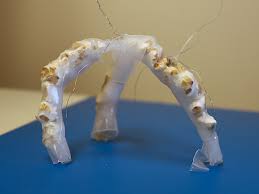Researchers at Cornell University have introduced an innovative concept: using popcorn as a one-time actuation mechanism for robotic devices. The idea builds on the fact that popcorn kernels are inexpensive, biodegradable, and edible. When heated, the kernels rapidly expand with considerable force—a transformation that, while irreversible, can be exploited for various robotic applications.
How It Works
Unpopped popcorn kernels act as compact reservoirs of mechanical energy. When heated, the moisture inside the kernels vaporizes, building up over 900 kPa of internal pressure until the kernel bursts open. The result is an expansion of at least five times the original volume—sometimes even up to 15 times larger, depending on the heating method. Researchers experimented with different types of kernels (including white, medium yellow, and extra small white varieties) and heating methods (hot oil, hot air, microwaves, and direct heating with a nichrome wire). They found that extra small white kernels not only cost less (around US $4.80 per kilogram) but also produced the highest expansion ratios when microwaved.
Actuation Mechanisms Explored
The research team showcased several potential applications for this popcorn-based actuation:
- Jamming Actuators: Typically, jamming actuators use granular materials like coffee grounds that become rigid under vacuum pressure. Here, the popcorn kernels, when heated and popped, create a jamming effect without needing a vacuum. In one demonstration, a chamber filled with 36 kernels managed to lift a 100-gram weight as they popped.
- Elastomer Actuators: By embedding popcorn kernels inside an elastic tube that’s constrained in one direction, the popping kernels can cause the tube to bend. Using three such actuators, the researchers built a three-fingered gripper capable of grasping a ball.
- Origami Actuators: Incorporating an origami-inspired design using recycled popcorn bags, a structure was created that expanded into a circle when activated by the popping kernels. In one test, 80 grams of popped kernels supported a weight equivalent to a 4-kg kettlebell.
- Indirect Actuation in Rigid-Link Grippers: Here, unpopped kernels placed in a flexible container are positioned between two plates connected by wires. As the kernels pop, the plates separate, pulling on the wires to drive a gripper mechanism.
Advantages and Potential Applications
While reversible systems using air inflation are common, they require additional hardware, whereas popcorn actuation only demands a simple heat source. This method is especially appealing for applications where a low-cost, disposable, or biodegradable solution is preferred—such as in single-use robotic deployments where the actuator’s irreversible change is not an issue. For example, a robot might use this mechanism to deploy insulation material or add structural support in isolated spaces by simply heating a packed chamber of kernels.
Insights from the Research Team
In discussions with the Cornell researchers, one key insight emerged: the idea originated with a focus on creating biodegradable actuators that exhibit dramatic mechanical changes upon activation. Despite the seemingly whimsical choice of material, the popcorn’s expansion properties proved to be highly effective. The team also noted that while similar functions could be achieved with air, popcorn offers a simpler, hardware-minimal alternative that might find niche applications, especially in scenarios where the one-time actuation is acceptable or even beneficial.
The novel use of popcorn in these actuators has sparked considerable interest within the robotics community, prompting discussions on how unconventional materials can lead to new, multifunctional design strategies.





